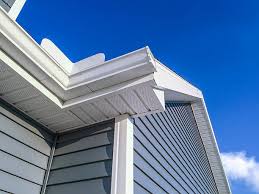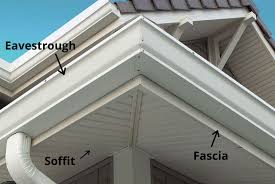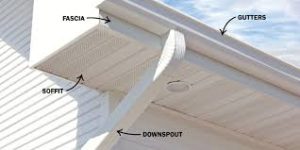


The Role of the Roof Edge System
While often overlooked, the eavestrough, soffit, downspout, and fascia form one of the most important systems protecting a home from the elements. In Eastern Ontario—where heavy rains, melting snow, and freeze-thaw cycles are part of the climate—these components work together to manage water, ventilate the roof, and preserve both curb appeal and structural integrity. A failure in any one part can quickly lead to leaks, ice dams, or costly foundation issues.
Eavestroughs (Gutters)
Commonly called gutters, eavestroughs run along the edge of the roofline and collect rainwater and melted snow, directing it toward the downspouts. In Eastern Ontario, the most popular materials are aluminum eavestroughs, valued for being lightweight, rust-resistant, and available in seamless options that reduce leaks. Vinyl is sometimes used for budget projects, though it can become brittle in cold winters, while steel or copper appear on higher-end or heritage homes. Properly sized eavestroughs are crucial, especially in areas prone to heavy snow loads and spring thaws, to prevent overflow and water damage to siding or landscaping.
Soffits
The soffit is the underside of the roof overhang, bridging the gap between the exterior wall and the fascia board. Traditionally made of wood, modern soffits are most often vented aluminum or vinyl panels, allowing airflow into the attic while keeping out pests. This ventilation is essential for preventing moisture buildup, reducing ice damming in winter, and helping shingles last longer. In older homes across Belleville, Quinte, and Prince Edward County, solid wooden soffits may still be found, often replaced over time with low-maintenance materials to withstand Ontario’s humid summers and frosty winters.
Fascia
The fascia board is the vertical finishing edge that runs along the roofline, directly behind the eavestrough. Its main job is to provide a solid mount for the gutters while giving the roofline a clean, finished appearance. Traditionally, fascia boards were constructed from wood and painted for protection, but today, most homeowners choose aluminum-wrapped or PVC fascia, which eliminates the need for constant repainting. In many of the region’s newer subdivisions, colour-matched fascia and soffit systems help tie together siding, trim, and eavestroughs for a polished, cohesive look.
Downspouts
The downspout is the vertical pipe that carries water from the eavestrough down to the ground, directing it safely away from the foundation. In Eastern Ontario’s climate, it’s critical that downspouts extend far enough away from the home to avoid basement leaks or foundation cracks. Extensions, splash blocks, or buried drainage systems are often used to control runoff. Like eavestroughs, most downspouts are made of aluminum, though copper and steel options exist. Square and rectangular profiles are the most common, chosen for efficiency and aesthetics.
Climate and Maintenance Considerations
The freeze-thaw cycles of Ontario can cause water to back up and freeze in poorly pitched gutters, leading to ice dams or damage. That’s why regular cleaning, proper slope, and good drainage are key. Leaf guards or mesh screens are also common upgrades in rural areas with mature trees. Ensuring soffit vents remain unobstructed helps maintain healthy airflow in the attic year-round, preventing condensation and extending the life of roofing systems.
👉 Together, eavestrough, soffit, fascia, and downspouts create a critical protective system—managing water, allowing ventilation, and enhancing a home’s curb appeal.

